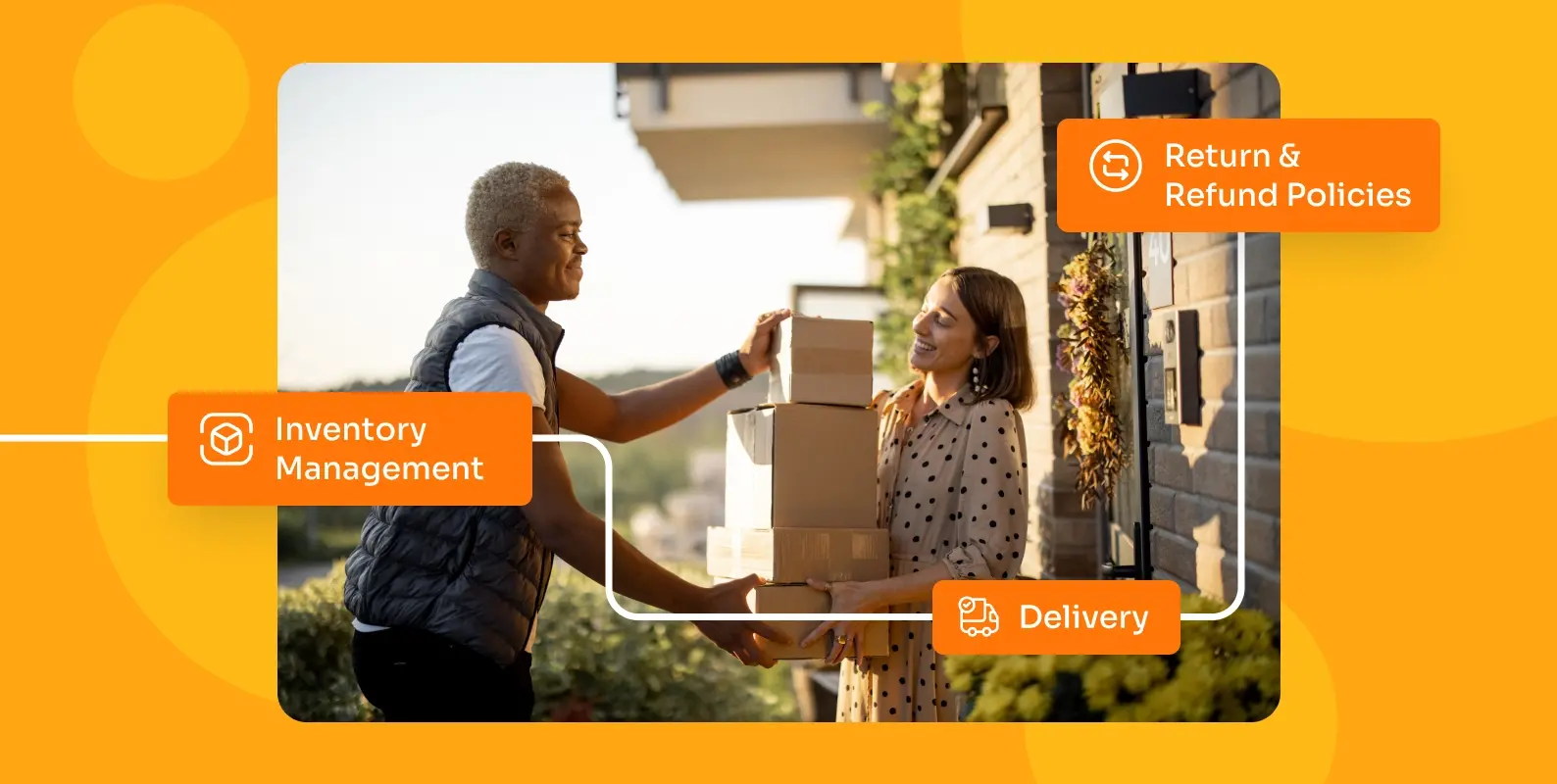Ecommerce logistics can often seem like a complex maze, but successfully navigating it can result in tremendous business growth and customer satisfaction. This critical aspect of ecommerce operations has seen a significant surge in importance over the past few years, with the global ecommerce logistics market projected to reach USD 535.89 billion by 2022. From inventory management to final customer delivery, the intricacies involved are numerous, and a strategic approach to handling them can be a game-changer for online businesses.
As rightly stated by Nabil Malouli, VP, of Global E-commerce for DHL,
“Ecommerce logistics is more than just ensuring your product arrives on time. It’s about building a framework that can handle rapid growth, seasonality, and peaks in demand, all while ensuring a seamless experience for the customer.”
Thus, understanding and effectively managing your ecommerce logistics becomes a cornerstone to enhancing your customer experience and your business’s profitability.
In this blog, we aim to help you demystify the ecommerce logistics maze and provide effective strategies to successfully navigate it. We will delve into the challenges and opportunities it presents, discuss key elements for success, and offer insights from industry leaders and case studies to guide you on this journey.
The Challenges in Ecommerce Logistics
While ecommerce logistics holds immense potential to boost customer satisfaction and bolster a business’s bottom line, it does come with its set of challenges. Here are some of the most common obstacles ecommerce businesses encounter in managing logistics:
Inventory Management: One of the significant challenges in ecommerce logistics is maintaining the right balance of stock. Overstocking can lead to increased storage costs and potential waste, while understocking can result in missed sales opportunities and dissatisfied customers.
Warehouse Efficiency: As your product range grows, warehouse management can become increasingly complex. This includes organizing products for easy access, managing warehouse staff, and maintaining safety standards. Automation can help, but it often requires a significant upfront investment.
Delivery Speed: Consumers have come to expect fast (even same-day) delivery on their purchases. However, offering such rapid turnaround times can be logistically difficult and costly, particularly for smaller businesses.
Shipping Costs: Shipping can be a significant expense for ecommerce businesses. Balancing the desire to offer free or low-cost shipping to customers while still covering costs can be a delicate balancing act.
Returns Management: No matter how good your products are, returns are a part of the ecommerce business. Managing these returns efficiently and cost-effectively can be challenging. Additionally, businesses need to strike a balance between offering a generous return policy and discouraging misuse.
International Shipping: As ecommerce allows businesses to reach a global audience, cross-border logistics become a challenge. This includes navigating customs regulations, dealing with longer delivery times, and handling additional paperwork.
Sustainability: Many consumers now want to know that their purchases aren’t harming the environment. However, implementing eco-friendly practices in your logistics operations, such as using sustainable packaging or reducing carbon emissions, can be challenging and often require additional investment.
Despite these challenges, effective management of ecommerce logistics can yield substantial benefits. By recognizing these potential obstacles and proactively developing strategies to address them, businesses can not only overcome these hurdles but also turn them into opportunities for enhancing customer satisfaction and profitability.
Implementing Effective Strategies for Ecommerce Logistics Success
With a solid understanding of ecommerce logistics, it’s now time to explore effective strategies that can drive your online business success.
1) Centralized Inventory Management: Keeping a real-time, centralized inventory management system is crucial. It allows you to have a holistic view of your stock levels across different warehouses or physical stores, helping avoid stockouts or overstocking.
2) Effective Warehouse Management: Streamline your warehouse operations to reduce errors and speed up processing times. This can involve implementing a warehouse management system, optimizing warehouse layout for efficiency, or automating certain processes.
3) Reliable Shipping and Delivery Partners: Your delivery partners are an extension of your brand. Work with reliable shipping partners who can ensure timely and safe delivery of products. Consider offering multiple shipping options, such as express delivery or pick-up points, to cater to different customer preferences.
4) Reverse Logistics: Having an efficient returns process is equally important. Make sure your reverse logistics are customer-friendly and efficient. This not only improves customer satisfaction but also allows for quicker resale or disposal of returned goods.
5) Sustainability Efforts: With increasing consumer awareness around environmental issues, incorporating sustainable practices in your logistics can be beneficial. This can involve using eco-friendly packaging, optimizing delivery routes for fuel efficiency, or partnering with carbon-neutral delivery services.
6) Use of Technology: Technological innovation has revolutionized the ecommerce industry, especially when it comes to logistics. New tools and software systems are making it easier for businesses to manage inventory, streamline shipping, and improve customer service. Let’s explore some of the ways technology is simplifying ecommerce logistics:
- Inventory Management Systems: These software solutions allow for real-time inventory tracking and forecasting. With automation features, businesses can ensure they maintain optimal stock levels, preventing both overstocking and stock-outs.
- Warehouse Management Systems (WMS): A WMS can improve efficiency and accuracy in warehouses. These systems help manage storage, picking and packing processes, and shipping, often using barcode scanning or RFID technology to track products.
- AI and Machine Learning: AI and machine learning can be used to predict consumer buying patterns and optimize inventory. They can also help with route optimization for deliveries, reducing time and fuel costs.
- Robotics and Automation: In larger warehouses, robotics and automation are increasingly being used to streamline operations. This can range from automated conveyor systems to robots that pick and pack orders.
- Integration with Shipping Carriers: Many ecommerce platforms now offer integrations with various shipping carriers, making it easy to print shipping labels, calculate postage, and provide tracking information to customers.
- Returns Management Software: Returns are a reality of ecommerce. Returns management software can streamline this process, making it easier for customers to return items and for businesses to process returns and issue refunds.
- Customer Relationship Management (CRM) Systems: CRMs can improve communication with customers, allowing businesses to send automated updates about shipping and delivery, handle customer queries more efficiently, and manage customer data.
- Analytics and Data Visualization Tools: These technologies allow businesses to gain insights into their logistics operations. They can identify bottlenecks, track performance, and use these insights to make data-driven decisions.
7) Customer Communication: Keep your customers informed at every step of the process, from order confirmation to delivery. This transparency can greatly enhance customer satisfaction and loyalty.
Case Studies: Successful Ecommerce Logistics Strategies
1) Amazon’s Prime Delivery and Warehouse Management

Perhaps the most iconic example in ecommerce logistics is Amazon. Its two-day (and now, in many cases, one-day or same-day) delivery promise through Amazon Prime has set the industry standard. To achieve this, Amazon has built a vast, efficient logistics network. It uses advanced warehouse management systems and has even incorporated robotics (through its subsidiary Amazon Robotics) to automate several parts of its warehouse operations. This helps speed up the order fulfillment process. Also, Amazon uses data analytics extensively to forecast demand and manage inventory efficiently.
2) Zara’s Fast Fashion Supply Chain

Fashion retailer Zara, a part of the Inditex group, has built its brand around ‘fast fashion,’ which relies heavily on a successful logistics strategy. Zara manufactures products in small batches, ensuring that its inventory is always fresh and in line with the latest trends. The company has a highly responsive supply chain, with a centralized distribution system that allows it to move products from design to store in just two weeks, far quicker than industry averages. This system depends on a high level of coordination and data sharing between Zara’s designers, factories, and stores.
3) ASOS’s Customer-centric Return Policy

ASOS, the British online fashion retailer, is a great example of a company that has nailed reverse logistics. Recognizing the importance of returns in the customer’s shopping experience, ASOS offers a ‘Free Returns’ policy. They provide multiple return options (like pick-up and drop-off points) and have a streamlined process to quickly handle returned items, which enhances customer satisfaction and encourages repeat purchases.
Conclusion
Mastering ecommerce logistics is an imperative for any online business. From managing inventory and streamlining warehouse operations to ensuring efficient shipping and handling returns, logistics plays a pivotal role in enhancing customer satisfaction and profitability. Although it presents its unique set of challenges, technological advancements offer tools to simplify these complex operations.
You may also like
Essential resources for your success
















